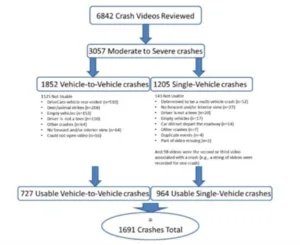The AAA Foundation of Traffic Safety has released a study on driving safety among teenage drivers in the US. The study takes into account the behavior of teenage drivers directly before an accident. The organisation calls this a “naturalistic” study. As you may envision, collecting information on how an accident occurred is very difficult, but this is exactly what the Foundation was able to do based on data collected by in-vehicle event recorders. These recorders are triggered in the case of a set acceleration force caused by fast cornering, braking hard or in the case of an accident.
Lytx has been collecting data from teenage drivers (16 to 19 years of age) who participated in the teen driving program. The device stores a video of the 8 seconds before and 4 seconds after the triggering event. The program started in August 2007 and continued to August 2013. Lytx analyzed medium to severe accidents where the acceleration exceeded 1g. This added up to a total of 1.691 accidents being analyzed.
Based on the 6s before the crash, the events were categorized by a variety of characteristics:
- Drivers and passengers
- Roadway and environment
- Crash type (vehicle to vehicle crash versus single vehicle crash)
- Driver behavior
- Passenger behavior
- Drowsy driving.
This leads to a very detailed database that can give answers on what the main distractions are in the case of an accident. In summary, the study finds that road conditions play a significant part, with 60% of the accidents happening in adverse road conditions. However, the affect of the road conditions varies largely by accident type. In 58% of all crashes the driver was involved in some form of distracted behavior. Most distracting behaviors include attending to passengers (14.9%) and cell phone use (11.9%). Cell phone use was much more prevalent in road departure accidents (34%). There is also a gender difference, women were more likely to use a cell phone than men (14% versus 10%). The study also found that using a cell phone was more likely when the driver was alone in the car. – NH

